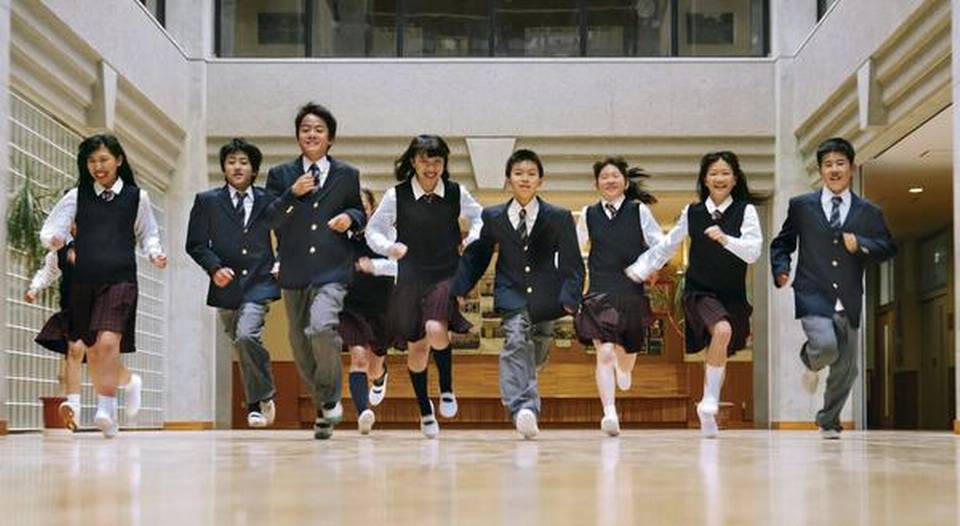
A cleaning rag is an essential part of a child’s school supplies in Japan
The classroom of any elementary school in Japan is filled with rows of fresh-faced children seated behind desks. Jackets will be slung on the backs of chairs. Textbooks will be out. So far, so standard. What differentiates these from other classrooms around the world is a hook under the tables from which dangles a cleaning rag or zokin. Along with stationary and notebooks, this rag is an essential part of a child’s school supplies, because in addition to reading, writing and maths, a major part of the educational curriculum in Japan comprises cleaning.
It’s lunchtime, on a chilly March afternoon, in a public elementary school in the affluent Tokyo suburb of Kichijoji. The two-dozen or so students in teacher Tanabe’s grade three classroom pack away their books and pull out lunch mats and chopsticks.
A small group of about five children don face masks, hairnets and white coats. They exit the room to return a few minutes later rolling in a trolley laden with school lunches. On offer is Miso soup, fried chicken, a green vegetable mix and bottles of milk. The children on duty for the day carefully serve out the lunches before eating their own food. Afterwards, they clean up the leftovers and take the trolley back to the kitchen space.
Armed with mops
The next 30 minutes are a flurry of activity as desks and chairs are pushed to the sides. It’s time to clean. Armed with mops and cleaning rags the children fan out across hallways, staircases, classrooms and the water coolers. Many kids zip about in a kneeling position, hands placed on the floor over a cleaning rag, elbows locked straight, and hips wiggling high in the air.
Some work earnestly, meticulously scrubbing away at stubborn stains. Others goof off, turning the cleaning session into a competition over who can clean fastest. Teacher Tanabe pitches in with a broom, occasionally calling out instructions over the bracing, marching music that’s been switched on.
Cleaning activities are formally mentioned in the Japanese government’s educational guidelines, but some discretion is granted to individual schools in implementation.
In the Kichijoji school for example, the children do not clean out the toilets, although some Japanese schools make that mandatory too and dispense with janitors altogether.
When asked what they like about cleaning, many children raise their hands. A bespectacled eight-year-old says, “The more trash I clean, the better I feel, specially when the teacher says, ‘well done.’”
What don’t they like about it? An equal number of hands shoot up. “It’s tiring,” complains one girl. “The water cooler area is too cold,” says another boy, mournfully.
But like it, or not, these children are going to clean up after themselves more or less every day for the rest of their school lives.
On special occasions they will even be sent out to clean the streets around their schools.
Arisa Koyama, one of the children’s mothers, recalls that cleaning up classrooms and public spaces was part of daily school life even when she herself was in elementary school back in the 1980s. “I think it helped us to really understand dirt, and become aware of the consequences of our actions.”
This may help explain the extraordinary cleanliness that is such a hallmark in Japan. There are few places in the world where someone can use a public lavatory with the kind of confidence in its usability that is the norm in Tokyo.
Public parks are pristine. The metro is often packed to the rafters, but it’s difficult to find a stain. At popular yoga classes, sessions don’t end with shav asana . Afterwards every student spends several quiet minutes wiping down yoga mats and cleaning the studio before exiting. Japanese soccer fans always take their trash with them when leaving a stadium.
Messy means nasty
Such care extends to private spaces too. Shoes are always removed, not only before entering homes but also at restaurants and often museums and dental clinics.
The centrality of cleanliness in Japanese metaphysics is evident from the language itself. Kirei , means clean, but also pretty, while fuketsu , or unclean, means hideous. Kitanai (literally dirty) means nasty, mean and calculating.
The cultural roots of this attitude are arguably located in Zen Buddhism where cleaning is part of a monk’s training on a par in status with meditation. Until the emergence of public baths in the 17th century, nearly all the baths for the common folk were provided by Buddhist temples.
But for school children, daily cleaning sessions have lessons that go beyond simple hygiene. Teacher Tanabe says cleaning helps inculcate the three values that are an essential aim of the educational system: working for others, working together and working seriously. It helps equip children with basic life skills, she says, and instils in them a collaborative spirit.
The result: cleaning is not seen as a punishment. It is not seen as beneath anyone’s dignity. It is not seen as dirty, but as the means to be clean. It is everyone’s duty and responsibility.
It would serve India well to look to Japan for more than bullet trains and nuclear technology. For a truly Swachh Bharat there is no better role model.
The writer is a globetrotter who is currently parked in Japan.
A bespectacled eight-year-old says, “The more trash I clean, the better I feel, especially when the teacher says, ‘well done.’”
Source: The Hindu [The importance of being kirei – Pallavi Aiyar]






